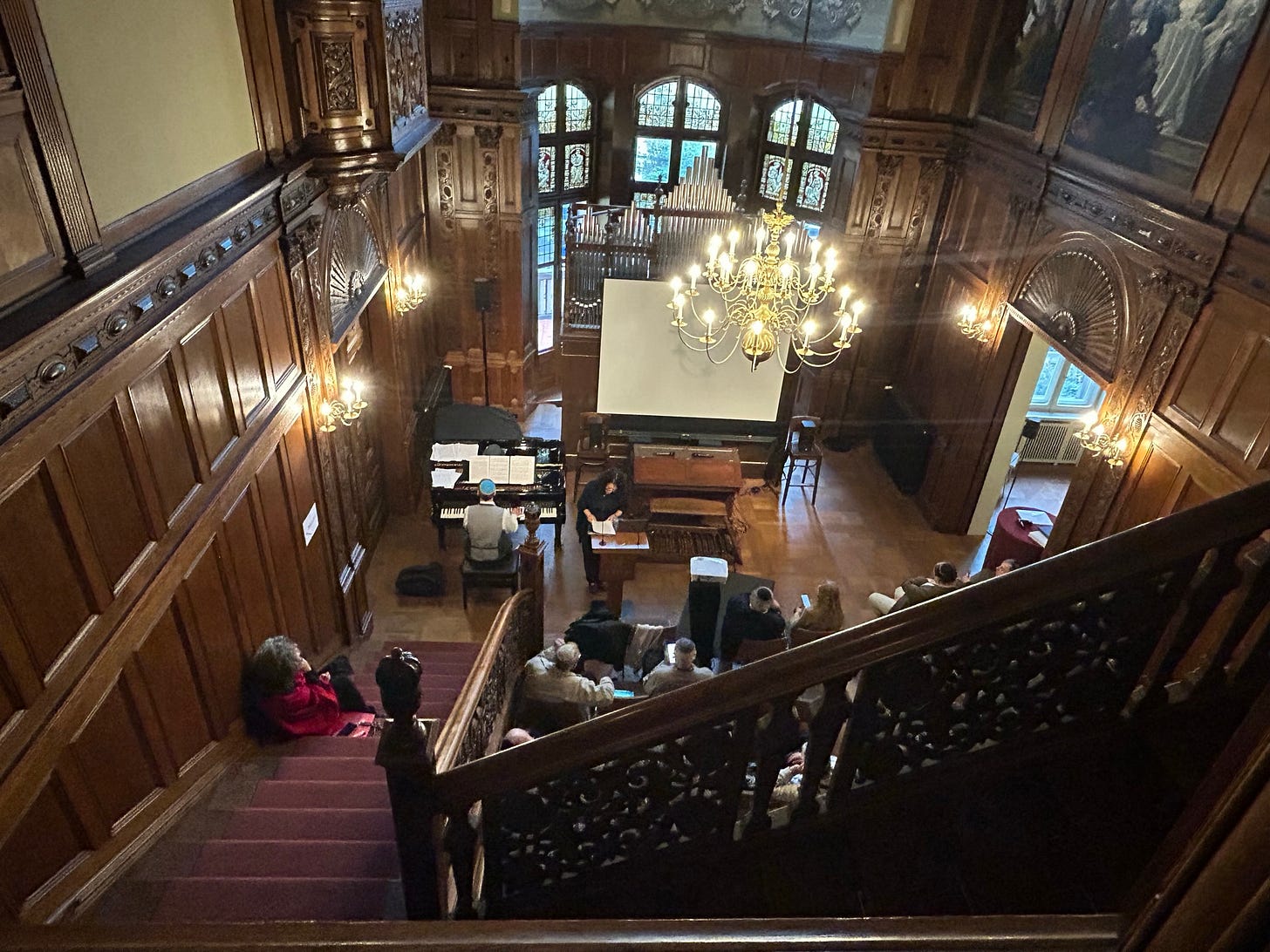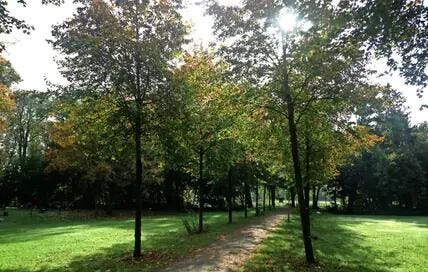Routine breeds familiarity. And within the predictable rhythms of life, time passes quickly. But when one is flung outside of routine, time slows to a crawl. The mind whirs to process new information, assimilate new patterns, and ultimately adjust with new responses. Full understanding is only available to us with the benefit of time.
I have spent the past seven days in Germany, and my mind is still with the many experiences, learnings, and feelings whose fullness of their meaning I cannot fully grasp. The intensity of the present is consuming, and the forest of reflection and understanding feels far from view. Yet this week I will try to make a beginning with three short vignettes, with the hopes that their meaning might show themselves.
The ECA: Musical Pluralism
This week I attended the European Cantors Association (ECA) conference in Hannover, Germany. Founded in 2012, the ECA “champions the traditional voice and role of the cantor,” and provides learning, support, and gatherings for cantors, prayer leaders and interested lay people across the denominational spectrum. While formally organized by orthodox cantors from the United Synagogue in Great Britain, participants in our conference spanned the entire gamut of Jewish affiliation, including Jewish Renewal, Liberal, Reform, Conservative/Masorti, and Orthodox.
This pluralistic success is because cantors are an open-minded bunch. The ability to sing together, regardless of creed, and also to give space to each other’s unique voices (in all senses) makes cantorial fellowship unique and precious. Such was what we found at our conference in Hannover, an Ashkenazi Brigadoon in which chazonus, tradition, and music history were given pride of place and cantors could recreate, ideate, and dream about the meaning of our shared aesthetic treasury.

We were hosted at the beautiful Villa Seligmann, Hannover’s center for Jewish music and culture and home of the European Center for Jewish Music. In this ornamented and cozy environment, cantors from all over the world gathered to present on topics such as modern liturgical composition, cantorial education, yiddish song, Jewsh history, German synagogue music, and practical issues of the cantorate. While the European context of cantorial work is very different from the American or Israeli one, the conference was a breath of particularly frische luft to its many international attendees, who found a tradition-positive, generous-spirited gathering in which shared love of Jewish music could be nurtured and celebrated.
A New Kantorenverband
One of the most fascinating developments of the conference was the announcement of the establishment of a new German cantors association, Der Verband Jüdischer Kantoren. This new organization sees itself as successor to the first German cantorial association, the Vereinigung Jüdischer Kantoren, which was founded in 1905 and cut short by the Nazis in 1939. The goals of the Verband are like those of the ECA, but are specifically geared towards serving and elevating the position of cantor in German communities. The organization has similarly pitched a big tent for cantors, with all Jewish denominations represented in its ranks (the leaders, Cantor Amnon Selig and Cantor Assaf Levitin, serve orthodox and liberal synagogues, respectively).
Having recently edited a book about the Cantors Assembly (now available online), it is very exciting to see a newborn cantorial organization. The Cantors Assembly long ago won many hard fought battles for the status and well-being of American cantors, including successfully arguing twice in federal court that cantors are recognized ministers of the faith and thus are entitled to parsonage. Seeing the Verband beginning to grow and advocate for its members, in a way, like watching a child begin to walk. Knowing both the challenges and the rewards ahead from the CA’s history only fills me with appreciation and excitement for the Verband and its leaders. If any readers are interested in supporting the Verband, please let me know.
The Cantor of Be’eri
Certain things about the war I can only imagine. And when I even try to imagine them, I cannot help but cry. And so I could not dry my cheeks hearing the chilling and inspiring tale of one of our delegates, Cantor Aviya Nachshon of Kfar Shmaryahu, a reservist who was released from his IDF unit in the South especially to attend our conference (he merited this because he personally volunteered to be the last soldier to get a break). Cantor Nachshon’s unit was tasked with the excruciating task of going through the homes of kibbutz Be’eri, coaxing scarred civilians from their shelters, removing the bodies of hundreds of massacred Israelis and slain terrorists, and preparing the former for collection and burial by Zaka.
I have avoided seeking out films of the Hamas atrocities. As an Israeli friend of mine wrote: “Don’t go out seeking the trauma. The trauma will find you.” Yet Cantor Nachshon went house to house. For days. Body after body. Men. Women. Children.
The son of a rabbi, Cantor Nachshon told us that he coped with this unthinkable task by channeling the clergyman’s experience of performing a funeral. This turned the constant stream of moving murdered and desecrated bodies into an act of religious service.
And Cantor Nachshon sang.
A mantra under his breath, he would lightly sing the cantorial piece “Akaviya Ben Mehalalel Omer” as he worked in Be’eri. This was no performance, but a whispered meditation on the meaning of life and death:
עֲקַבְיָא בֶן מַהֲלַלְאֵל אוֹמֵר, הִסְתַּכֵּל בִּשְׁלשָׁה דְבָרִים וְאִי אַתָּה בָא לִידֵי עֲבֵרָה. דַּע מֵאַיִן בָּאתָ, וּלְאָן אַתָּה הוֹלֵךְ, וְלִפְנֵי מִי אַתָּה עָתִיד לִתֵּן דִּין וְחֶשְׁבּוֹן. מֵאַיִן בָּאתָ, מִטִּפָּה סְרוּחָה, וּלְאָן אַתָּה הוֹלֵךְ, לִמְקוֹם עָפָר רִמָּה וְתוֹלֵעָה. וְלִפְנֵי מִי אַתָּה עָתִיד לִתֵּן דִּין וְחֶשְׁבּוֹן, לִפְנֵי מֶלֶךְ מַלְכֵי הַמְּלָכִים הַקָּדוֹשׁ בָּרוּךְ הוּא:
Akaviyah ben Mahalalel said: “Mark well three things and you will not come into the power of sin: know from where you come, and where you are going, and before whom you are destined to give an account and reckoning. From where do you come? From a putrid drop. Where are you going? To a place of dust, of worm and of maggot. Before whom you are destined to give an account and reckoning? Before the King of the kings of kings, the Holy One, blessed be He” (Pirkei Avot 3:1).
Chazonus is powerful because it expresses the “soul of the word.” But transcendence like this reminds me that chazonus is also powerful because it processes trauma.
The famous cantor Jack Mendelson, who grew up in the cantorial culture of mid-20th century Boro Park, recalls that people would go to shul to cry. For their suffering. For the loss of the shtetl. For the Shoah. For traumas known and unknown. The traditional cantorial style, particularly Eastern European, created (and still creates) a musical space for tears, for anger, for bargaining, and eventually for acceptance. It is an amplified sonic journey through the stages of grief. Perhaps now, we need that sonic space more than ever.




